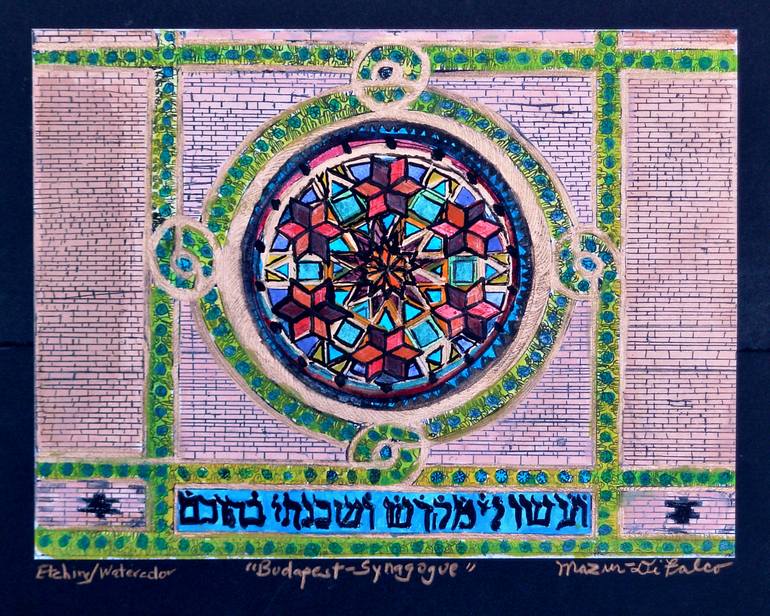


VIEW IN MY ROOM
Synagogue in Budapest Painting
United States
Painting, Ink on Paper
Size: 14 W x 10 H x 0.1 D in
Ships in a Box
Artist Recognition

Artist featured in a collection
About The Artwork
Di Falco unites the genres of printmaking and painting in this unique work on paper, which also depicts another scene from the city of Budapest. He began to enhance his etched artist’s proofs after losing access to his etching studio a half year ago because of the viral crisis. He hopes to return to his studio after Labor Day of 2020. The media for this pictured work on paper includes: etching ink; RivesBFK white paper; gouache; pulverized mica; gold dust; Gouache, and, Winsor Newton watercolors. The image—adapted from a photo taken by the artist—depicts The Dohány Street Synagogue, also known as the Great Synagogue or Tabakgasse Synagogue, a historical building in Erzsébetváros, which is the 7th district of Budapest in Hungary. This architectural wonder is among the top ten sights of this exotic city. The etched artist proof was originally hand printed and published at The Center for Works on Paper in Philadelphia, Pennsylvania. After adding water-base media to the proof, Di Falco trimmed the work and mounted it on The Hebrew inscription on the building quotes Exodus and translates, “And let them make Me a sanctuary that I may dwell among them.” The work ships to the buyer with both a mat and frame.
Details & Dimensions
Painting:Ink on Paper
Original:One-of-a-kind Artwork
Size:14 W x 10 H x 0.1 D in
Frame:Other
Ready to Hang:Not applicable
Packaging:Ships in a Box
Shipping & Returns
Delivery Time:Typically 5-7 business days for domestic shipments, 10-14 business days for international shipments.
Handling:Ships in a box. Artists are responsible for packaging and adhering to Saatchi Art’s packaging guidelines.
Ships From:United States.
Have additional questions?
Please visit our help section or contact us.
United States
Imagery and storyline—both vital components of my creative process—enable me to create a form of visual poetry. Consequently, photography is intricate to my artistic strategy, especially with regard to my etchings. In view of this, many of my printed images—accomplished via the studio techniques of intaglio, aquatint, drypoint, and Chine collè—originate from my own photographs, as well as ones I uncover during research into the archives of academia, historical societies, and museums. Upon locating a scene that fascinates me, I first sketch a few original drawings of the likeness, and next transfer that drawing onto my prepared zinc etching plate. NOTE: In my etchings that incorporate the Chine collè process, I use mulberry bark paper from Thailand, which is infused with Japanese kozo threads. The paper is also treated with methylcellulose. I endeavor to establish links between the metaphysical and physical worlds . . . between the realms of dream and reality . . . and between the natural and the fabricated. In a sense, I believe that art unveils everything that we mask behind our assumptions and biases . . . or rather, those realms we neglect—or refuse—to perceive. My label for our failure to examine these areas is, “The Phenomenology of Non-Connectedness", which I blame on today’s communicational tools such as Social Media, the Internet, texting on smart phones, and “tweeting”. MY ETCHING TECHNIQUE I work on metal etching plates treated with both hard and soft grounds. These grounds consist of mineral spirits, beeswax, oil of spike lavender, and other natural substances. After these grounds dry, I draw images with needles and other tools onto the plate. Next, the exposed areas are “etched into” the zinc or copper plate in a bath of Nitric Acid and spring water. An artist’s proof in then printed after the plate is cleaned; Moreover, two to seven additional plate workings, acid baths, and proof printings occur before my desired effect is obtained. When satisfied with my end result, I apply oil based etching ink onto the clean plate and then remove the excess ink with several wipes. Next, I align my etching plate onto the printing press bed and cover it with papers and press blankets. Finally, the plate goes through the press to obtain my print. This process is repeated until all editions are created. I usually create three to five editions of five or six etchings for each one of my plates.
Artist Recognition

Artist featured by Saatchi Art in a collection
Thousands Of Five-Star Reviews
We deliver world-class customer service to all of our art buyers.
Global Selection
Explore an unparalleled artwork selection by artists from around the world.
Satisfaction Guaranteed
Our 14-day satisfaction guarantee allows you to buy with confidence.
Support An Artist With Every Purchase
We pay our artists more on every sale than other galleries.
Need More Help?